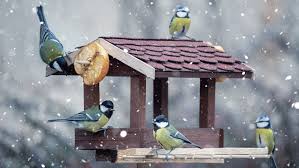Tuesday Tips It's for the birds!

Why are birds important to the environment?


The Best Foods to Offer Birds in Autumn
In addition to natural foods from berry bushes, nut-bearing trees, and ripe grasses, try offering birds these foods:
Sunflower Seeds
These are the go-to seeds for attracting and feeding the most backyard birds. Hulled sunflower seeds offer fast energy for any visitors, while in-shell sunflower seeds are better for larger songbirds and any birds caching seeds for winter use. Birds will also pluck seeds right off ripe sunflower heads if available.
Nyjer Seed
These tiny seeds are very oily and high in fat and calories, making them a favorite for many fall and winter finches, including goldfinches, redpolls, crossbills, and siskins. Offer Nyjer seed in mesh feeders or sock feeders that tiny birds will cling to for easy feeding.
Peanuts and Peanut Butter
Rich in fat and calories, peanuts and peanut butter are great foods for woodpeckers, jays, nuthatches, and many other birds. In-shell nuts will quickly be hidden for winter storage, while peanut hearts and peanut butter are a fast energy source on autumn days.
Suet
The ultimate high-fat food for autumn birds, suet is great for woodpeckers, titmice, wrens, chickadees, bluebirds, and jays. You can offer suet in cakes or blocks, crumbled, chopped, or shredded for smaller birds. Plain suet is fine, or opt for a variety mixed with seed, bits of nuts, or even dried insects for more nutrition.
Cracked Corn
Though lower in overall nutritional value, cracked corn is a hearty carbohydrate that will help birds fuel up, and it is less expensive for fulfilling big autumn appetites. Sprinkle cracked corn on the ground for grouse, quail, doves, sparrows, turkeys, and other ground-feeding birds.
Nectar
Though hummingbirds and orioles head south in autumn, offering nectar right into the cold season will ensure they have an easy food source to visit as they travel. Take steps to keep nectar from freezing in late autumn. Remove nectar feeders completely when they haven’t been used in 10 days or more.
Quick Tips for Fall Bird Feeding

- Switching to larger feeders in fall can ensure the birds have plenty of food to use
- Leave natural foods in the yard intact, including leaf litter, and avoid unnecessary pruning at a time when birds will happily clean the last seeds, ripe fruits, or insects from the plants
- Be sure bird baths are fresh and full so visiting birds also have a source of water for drinking and bathing
Autumn is a season of abundance. By recognizing how birds take advantage of that abundance to adapt their diets, birders can take advantage of different bird foods and feeding techniques to enjoy all the best of fall birding right in the backyard.
- Carole Zellers